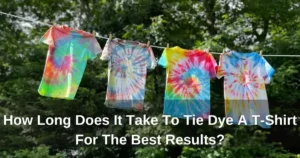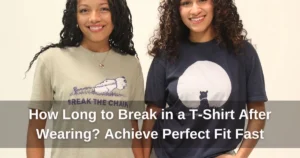No one wants to waste money on a so-called “vintage” t-shirt only to realize later that it’s just a modern reproduction. Unfortunately, without the right knowledge, it’s easy to fall into this trap. In this guide, Yes T-Shirt breaks down how to know if a T shirt is vintage, from fabric and stitching to tags and fading patterns. Let’s check it out!
How To Know If A T-Shirt Is Vintage? 10 Easy Ways To Check Out
Old-school or vintage t-shirts have a special appeal, but with so many knockoffs in stores, how do you know if a shirt is from back in the day? Here are 10 ways that are usually used by fashion experts to check if a T-Shirt is the real deal.
1. Check The Age
The main thing that makes a t-shirt vintage is its age. To be considered authentic, it needs to be at least 20 years old. Anything newer is just “vintage-style,” which means it looks old but doesn’t have the history behind it. Always check when the design first comes out to see if it’s legit. Of course, many sellers will try to trick you by distressing a t-shirt to make it look like a real vintage shirt.

Recheck the age of the T-shirt in behind (Source: cooltees.nz)
2. Examine The Tag
A glance at the tag can offer helpful hints. Old-school t-shirts often sport tags from brands like Screen Stars, Stedman, 3D Emblem, Nutmeg, and Logo 7—these were common blanks for screen printing back in the day.
Meanwhile, Big names in sportswear and streetwear such as Nike, Russell Athletic, Adidas, and Champion also had their unique vintage tags. If the tag seems too fresh or shows modern branding, the shirt might not be the real deal. Also, some genuine vintage items might have a worn-out or missing tag because of years of use.
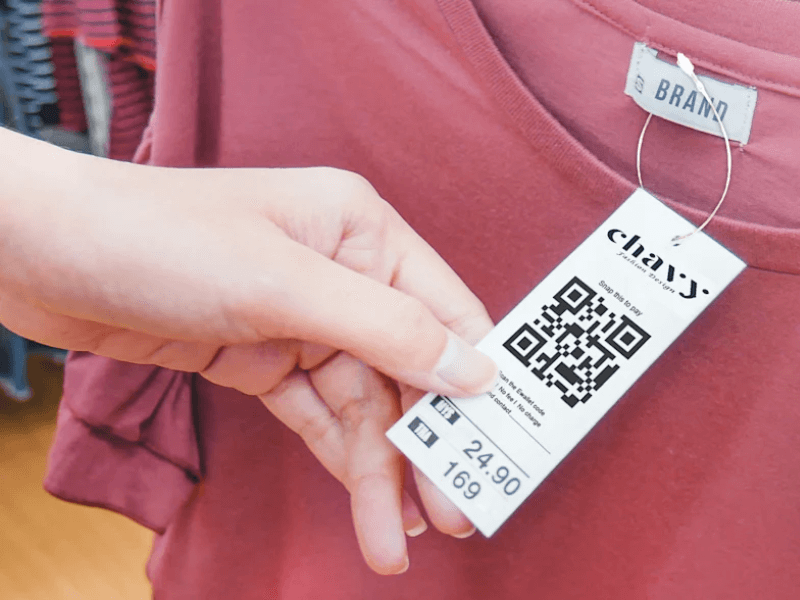
You should check the T-shirt tag first (source: neonvintage)
3. Check the Stitching
As you probably know, T-shirt making has changed over time. Before the mid-1990s, t-shirts had single stitches on the hems and sleeves. Now, t-shirts have double stitches to last longer.
When you check an old-looking t-shirt, look at the sleeve hems – one stitch often means the shirt was made before the mid-’90s. But remember, some new brands now use this old way too, so don’t just rely on this.
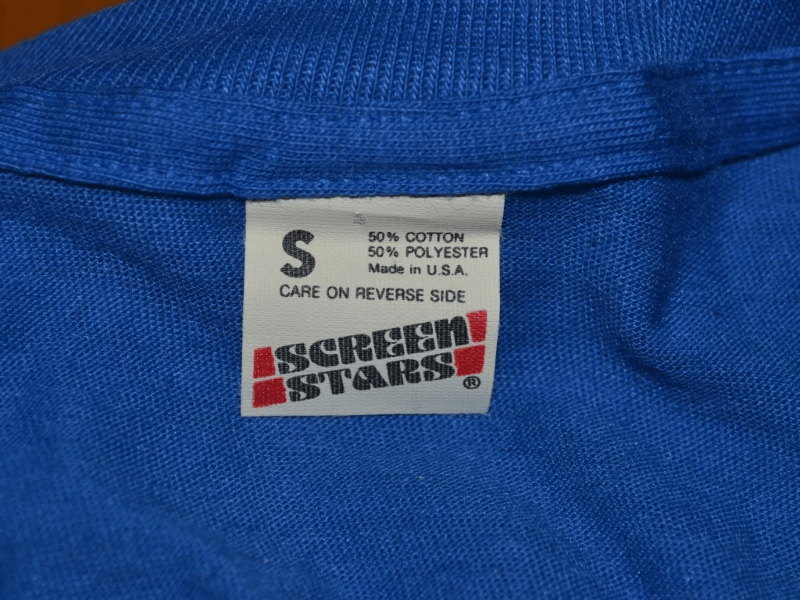
Stitching might be the other key factor to consider (Source: Commavintage.com)
4. Look for a Date on the Graphic
Many old t-shirts, those with band logos, movie ads, or event prints, have a small copyright date in the design. You can often spot this near the bottom of the picture. If you see a date from the ’80s or ’90s, it’s a good sign that the t-shirt is real. But be careful! Some fake old shirts put fake dates on them to trick buyers. Of course, you should make sure to check other things too before you decide.
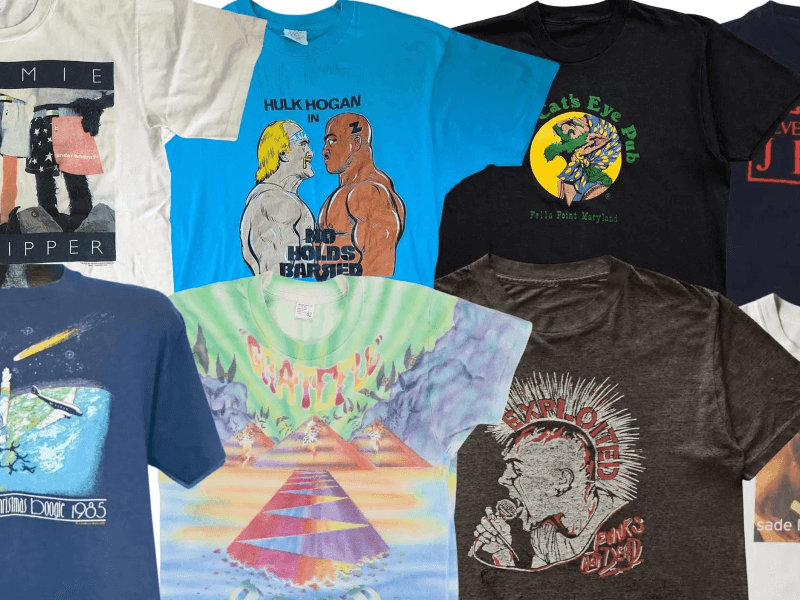
The date on the T-shirt’s graphics might be the key factor for its vintage (source: GQ.com)
5. Feel the Fabric
Old t-shirts have a unique texture from years of use and washing. Real vintage shirts with a 50/50 cotton-polyester mix often feel more delicate and smooth than today’s mass-produced ones. If the material seems too rigid or new, it’s likely a copy. Also, older tops might show slight fading or cracks in the T-shirt design, which adds to their genuineness.
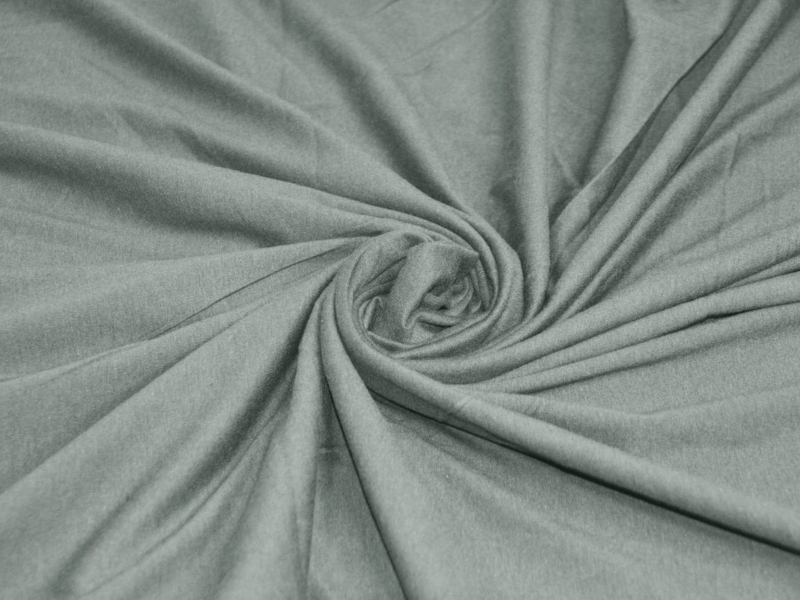
Check out the fabric with the signature of vintage T-shirt (Source: mytextllefabric.com)
6. Price and Rarity
Vintage T-shirts can cost more than those with popular designs, band images, or limited edition prints. The less common the item, the more expensive it is. If you find an “old” T-shirt for a low price, you should look closer. On the other hand, not all costly T-shirts are old; some sellers simply markup the price because of the rarity of the design or accessory on the shirt.
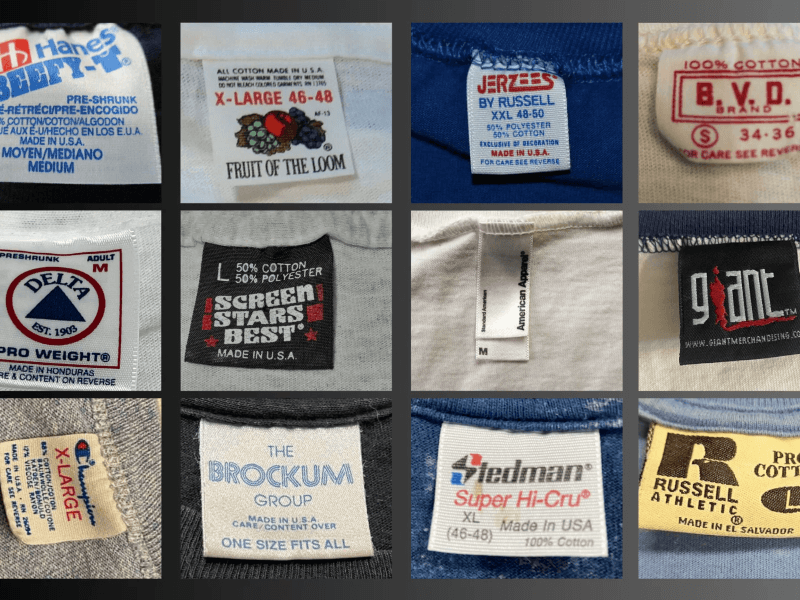
The more rarity T-shirt is, the more vintage it come up with (Source: Crusherdistroyer.com)
7. Do a Quick Google Search
One next tip is that when you’re not sure, a speedy online check can help confirm if something’s real. Search for the brand tag, stitching, and print design to see if they match authentic old pieces. Websites, forums about vintage stuff, and resale sites like Grailed, Depop, and eBay often show items with detailed info that can act as a guide.
8. Graphics & Print Aging
The most accurate method of identifying a genuine vintage t-shirt is by looking at its graphics and prints. Vintage prints tend to fade, crack, and soften over time with constant washing and wear. Unlike modern reproductions, which have an artificial distressed and ‘new’ look, genuine vintage prints age organically.
Older designs usually have thinner ink, with the color integrating into the shirt rather than sitting on top of it. A shirt with rubbery and plasticky prints is likely a modern reproduction.
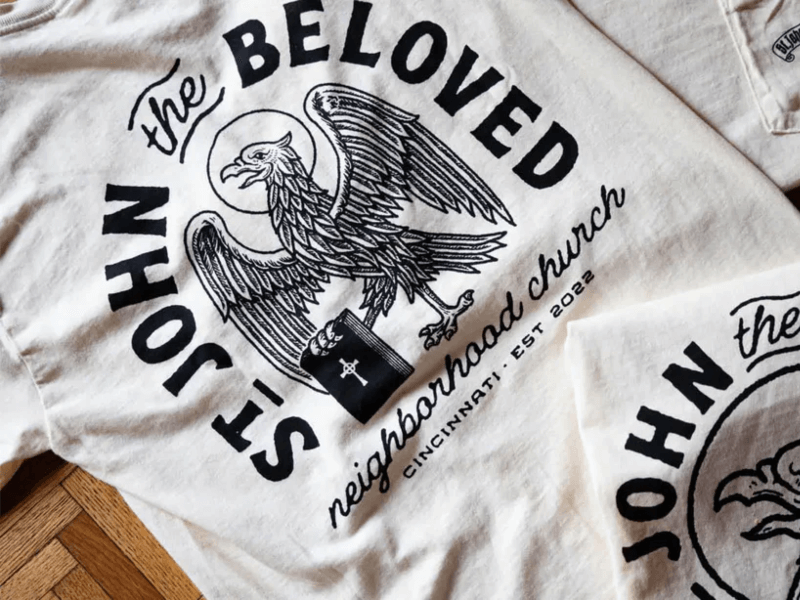
The unique graphic or printing might confirm its price and vintage (source: Kreafolk.com)
9. Holes & Stains
August ’80s and throughout the ’90s saw an increase in the copyright details near shirt designs, so try looking for that; it can help determine authenticity.
A truly vintage t-shirt will have slight discolorations with small holes cut and frayed edges. These usually occur around the collar, hem, or underarms. These imperfections are a natural result of use, making them a key sign of authenticity.
However, not all holes and stains mean a shirt is vintage. The difference? Unplaced wear and tear versus strategically placed artificial fraying.
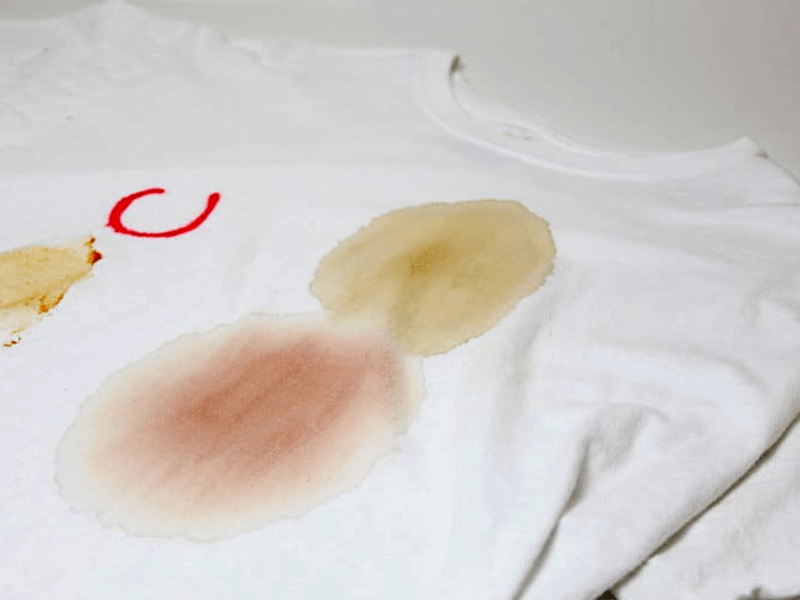
Source Defunkd.com
Where to Find Authentic Vintage T-Shirts?
Finding genuine vintage t-shirts requires more than just browsing any random store. To score truly unique pieces, you need to know where to look. Here are the 3 best places that we recommend for you to explore:
1. Thrift Stores & Charity Shops
The search for antiques brings customers to thrift stores along with charity shops. Donations at these stores constantly release unique items, including band memorabilia and period sportswear, in addition to vintage graphic designs. Regular visits are important as the inventory changes frequently.
2. Antique Stores
These stores select well-preserved, high-quality vintage items, unlike regular thrift stores. You will be purchasing authentic items from specific eras at a higher cost, but they will be well-preserved at antique stores. However, you should consult with the store owner to verify the historical details of each item as this helps to authenticate their authenticity.
3. Flea Markets & Swap Markets
These markets often have independent vendors who specialize in vintage fashion. Take a look at their collection and don’t be afraid to bargain. Many sellers are willing to haggle, especially if you’re buying multiple items.
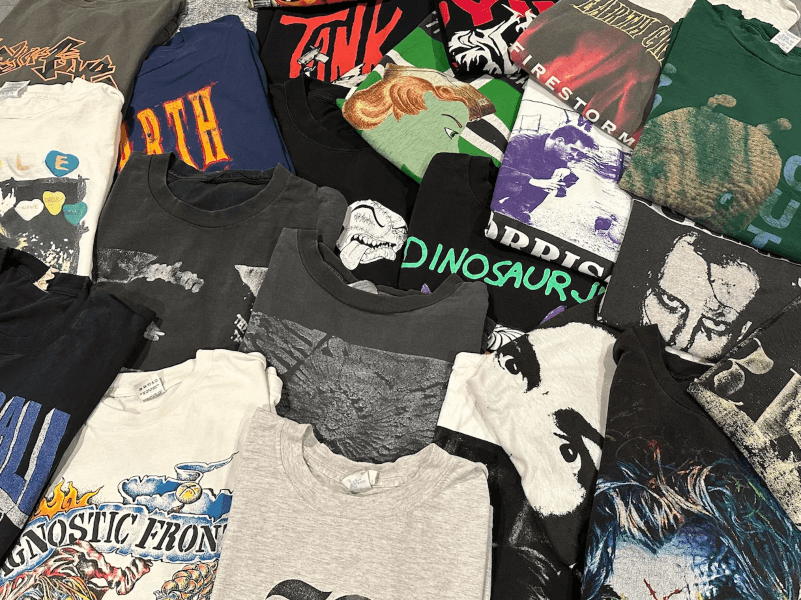
You can buy unique and luxury T-shirts in these local store (source: maddvintage.com)
FAQs
How Old Does a Shirt Have To Be Vintage?
A shirt is generally considered “vintage” if it is at least 20 years old, although some collectors might use a stricter definition and say it needs to be at least 50 years old to be considered “true vintage.”
Why Are Vintage T-Shirts So Expensive?
Vintage t-shirts can be pricey because they are rare and bring back nostalgic memories. Many were made with high-quality materials that last, making them even more valuable. Besides, collectors are also willing to pay more, especially for shirts featuring famous bands, movies, or cultural events.
How To Preserve Vintage T-shirts?
First, try to wash them gently in cold water using a mild detergent, and always turn them inside out to protect the design. Besides, you should skip the dryer and let them air dry instead to avoid shrinking and fading. When storing, keep them in a cool, dark spot, away from direct sunlight, so the colors stay vibrant for longer .
Conclusion
In short, we covered how to know if a T Shirt is vintage. As vintage t-shirts gain popularity, more fashion lovers and collectors are eager to uncover their hidden stories. To verify a shirt’s authenticity, it’s essential to examine key details like its age, rarity, and tags.
Pay close attention to fabric quality and print design, as these elements reveal whether the piece is genuinely vintage or just a modern reproduction. A thorough inspection ensures you’re investing in an authentic collectible rather than a replica.





